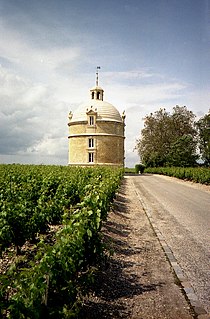History of Bordeaux wine

Roman times
Bordeaux wine production seems to have begun sometime after 43 AD, during the Roman occupation of
Middle Ages
Although domestically popular, French wine was seldom exported, as the areas covered by vineyards and the volume of wine produced was low. In the 12th century however, the popularity of Bordeaux wines increased dramatically following the marriage of
As the popularity of Bordeaux wine increased, the
The citizenry of Bordeaux worked diligently to promote and foster their relationship with the English market. In 1205, King Alfonso VIII of Castile laid claim to Aquitaine and put Bordeaux under siege. The village was able to withstand the attack and King John rewarded the Bourgeois with orders for wine in excess of 120 tons. In 1224, King Louis VIII of France attempted to purge the English from French soil and was halted in his advance in the town of Bordeaux. In the aftermath Bordeaux received privileged access to the English market through London, and their exports to the market soon dwarfed the production from other French wine making regions.[7]
During the 13th century, the
As part of the
Second golden era

In the seventeenth century,
In 1725, the spread of vineyards throughout Bordeaux was so vast that it was divided into specific areas so that the consumer could tell exactly where each wine was from. The collection of districts was known as the Vignoble de Bordeaux, and bottles were labeled with both the region and the area from which they originated. During this period, Nicolas-Alexandre, marquis de Ségur rose to prominence as the "Prince of Vignes" due to his ownership of some of Bordeaux's most prestigious estates and Pierre de Rauzan laid the foundation for Château Rauzan-Ségla, Château Rauzan-Gassies, Château Pichon Longueville Baron, and Château Pichon Longueville Comtesse de Lalande.[15]
In 1855, a classification system was set up that ranked the top chateaus of the Médoc according to their market price.[13]
Phylloxera epidemic
From 1875 to 1892 almost all Bordeaux vineyards were ruined by
Economic uncertainty
Due to the lucrative nature of this business, other areas in France began growing their own wines and labeling them as Bordeaux products. As profits in the
In the twentieth century, the
20th century

In 1936, the government responded to the appeals from the winemakers and stated that all regions in France had to name their wines by the place in which they had been produced. Labeled with the
The economic problems in the 1970s, in the wake of the
This critical selection of grapes also resulted in many chateaux introducing
Bordeaux used to have a significant production of white wines, with Entre-deux-Mers, a primarily white wine area. Unlike the style of dry white Bordeaux favoured today, with almost 100% Sauvignon Blanc and a heavy influence of new oak, the traditional Entre-deux-Mers whites had a high proportion of Semillion and were made in either old oak barrels or steel tanks. Starting in the 1960s and 1970s, these vineyards were converted to red wine production (of Bordeaux AOC and Bordeaux Supérieur AOC), and the production of white wine has decreased ever since. Today production of white wine has shrunk to about one tenth of Bordeaux's total production, with 11.0% of the vineyard surface in 2007 used for white wines (7.8% for dry, 3.2% for sweet).[21]
References
- ISBN 1-56305-434-5
- ISBN 0-671-68702-6
- ISBN 0-671-68702-6
- ISBN 0-671-68702-6
- ^ a b c d e f "Official Bordeaux website". April 18, 2007. Archived from the original on September 27, 2007.
- ISBN 0-671-68702-6
- ^ ISBN 0-671-68702-6
- ISBN 0-671-68702-6
- ISBN 0-671-68702-6
- ISBN 0-671-68702-6
- ISBN 0-671-68702-6
- ^ "BBC". 2014-09-09.
- ^ ISBN 1-74048-050-3
- ISBN 0-671-68702-6
- ISBN 0-671-68702-6
- ^ ISBN 1-74048-050-3
- ISBN 978-1-84000-980-4.
- ^ Stephen Brook, The Complete Bordeaux – The Wines – The Châteaux – The People p. 30-31. Octopus Publishing Group Ltd. 2007
- ^ a b Stephen Brook, The Complete Bordeaux – The Wines – The Châteaux – The People p. 31. Octopus Publishing Group Ltd. 2007
- ^ Stephen Brook, The Complete Bordeaux – The Wines – The Châteaux – The People p. 31-32. Octopus Publishing Group Ltd. 2007
- ^ CIVB: Production Archived 2012-03-22 at the Wayback Machine, accessed on December 18, 2009
